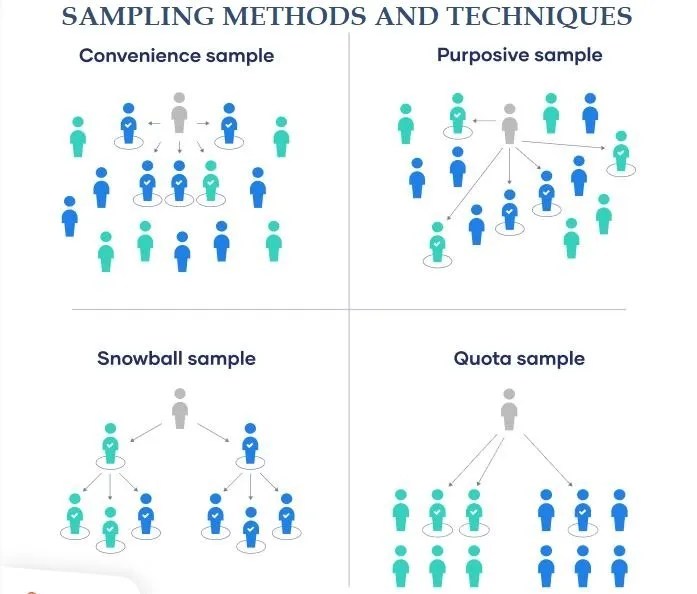
Sampling Techniques and Methods vary considerably, depending on the end result desired, and for which the organization, researcher or institution has set out to gather information. The kind of information desired can also determine the most effective method of Sampling which should be used.
In this post we will review the various sampling techniques and methods including definitions, but without any critical bias. This will enable each reader determine what sampling method best suits his academic pursuits, or research purposes. The proper place to start is to provide a definition of Sampling.
What Is Sampling?
Sampling is an attempt to gather data or information from a population without reaching all individuals within the population. A selection of a subset of individuals is made from the entire population with the understanding that this small group will provide answers that are consistent to the entire statistical population. Sampling is an important part of statistics and quality assurance.
Remember that for the results of Sampling to be valid, careful consideration must be made to determine how it will be done.
Two (2) Sampling Methods
As opined above, there are 2 major sampling methods. These methods have been broken down into clearer terms for you to properly understand and make an informed decision on which is best for you depending on the case.
1. Probability Sampling
Probability sampling involves random selection of individuals from the population. Even though this may seem like random guesswork, it is interesting to note that this is one of the ways to make strong statistical inferences about the whole group because no biases interfere with the selection process by which participants for the study are made. This means that whatever conclusions are drawn after the sampling is done will reflect facts about the group, regardless of whether the individuals are big or small.
2. Non-Probability Sampling
Non-probability sampling involves non-random selection. This could be based on convenience or other factors; which the researcher may believe will help with the collection of data. Non-Probability sampling sometimes involves the researcher choosing people who he thinks are best suited to the questions. A common flaw of this type of sampling is that the results may reflect the researcher’s previous bias, even those he may have unconsciously.
Whatever Sampling Method One Chooses should be clearly stated in the report so as to help those in charge of use of collected data know how they are going to analyze and use the information.
Now that we have discussed what Sampling is, and what the types of Sampling are; it is important to discuss the various methods via which it can be done.
The Methods of sampling can be broken down according to the various types.
Types of Sampling Methods
A) Probability Sampling Methods
Basically, there are various sampling techniques and methods under the probability sampling method. These are sampling methods in which every member of the population stands an equal chance of participating in; there are no individuals automatically ruled out at the onset.
1. Simple Random Sampling
A simple random sampling is one in which every member of the population has an equal chance of being selected. This means the Sampling Frame will include the whole population. People would then be selected on something random; something that any member of the population, whether big or small may possess.
For example:
- One can assign numbers to everyone in a company database, and then use a computer application to select 100 numbers.
- One can also write names of everyone in a company, and then put them in a pot or container, and then just put ones hands in the container, bringing out every name that comes out; just like a raffle draw.
2. Systematic Sampling
Systematic sampling is similar to simple random sampling because the aim is to select people randomly, or without any prejudice or bias. This may even be a lot easier to conduct than simple Random Sampling. In this case every member of the population is assigned with a number, but instead of randomly generating numbers, individuals are selected at regular intervals.
Example: Systematic Sampling
- All employees of the company can be given numbers assigned to them in alphabetical order. Depending on the size of the population, numbers can be selected by the 2s, 5s, 10s, 20s, 50s, 100s, and so on.
- One can even stay on a busy street, and decide to interview people in a similar manner; approaching one person in every 10 or 20 or 30, and so on. Any other random formula can also be used to the same effect, as long as the participants are chosen with the same system, without any bias.
3. Stratified Sampling
Stratified sampling is a way to get much more accurate conclusions because it takes note of important differences that make occur among people within the population. With Stratified Sampling, the population is divided into subpopulations, depending on the important distinctions within them.
The subpopulations are called strata; and some of the factors according which they are divided include; gender, age range, income bracket, and so on. Sometimes strata may include religion, ethnicity, and political affiliations; depending on what data the research is looking to draw.
By dividing the entire population into strata one is able to draw more accurate conclusions because more people within each of the strata will be touched, and also because the answers obtained will be divided among the various subgroups, and so you can tell what section said yes or no.
Example of Stratified Sampling
- In a city with 5 million men and 6 million women you want to group the respondents into females and males so that you know what section approves of government policies, and what section disapprove.
4. Cluster sampling
Cluster sampling also involves dividing the population into subgroups, based on important distinctions that may exist between them; however, it may not touch individuals within the groups. This is because each subgroup is treated as an individual; rather than sampling individuals from each subgroup, entire subgroups are randomly selected.
Cluster Sampling may come with some risk of error, but is widely used, especially when the populations are large, or when they are widely dispersed.
Individuals from each clusters can also be Sampled if possible; this will help to arrive at conclusions covering other members of the clusters, and when the whole process is done, the conclusions would be sure to have included every cluster or sector of the population.
As mentioned above, there is a risk of errors; especially because the answers received may not represent the opinions of the clusters which they reportedly represent, and also because the clusters themselves may not exist as reported.
Example: Cluster sampling
- A company has offices in 10 cities across the country, and they all have roughly the same number of employees working in similar roles. One may not have the resources to travel to every office to collect the data, and so may use random sampling to select 3 offices. These offices become the clusters, and answers obtained will be deemed true in the remaining 7 offices, even though that may not truly be the case.
B) Non-Probability Sampling Methods
In a non-probability sample, individuals are selected based on non-random criteria, and not every individual has a chance of being included.
This type of sample is easier and cheaper to access, but it has a higher risk of sampling bias. That means the inferences you can make about the population are weaker than with probability samples, and your conclusions may be more limited. If you use a non-probability sample, you should still aim to make it as representative of the population as possible.
Non-probability sampling techniques are often used in exploratory and qualitative research. In these types of research, the aim is not to test a hypothesis about a broad population, but to develop an initial understanding of a small or under-researched population.
Non Probability Sampling
Non probability sampling is designed to take all the randomness out of Sampling. Contrary to what a person might expect this may not always lead to more trust worthy answers, but it makes the work of Sampling more controlled, removing complexities, and making the work of sampling a lot easier.
Interestingly these easy sampling methods are not the most admired by professionals; and the results are not mostly used in important or sensitive research projects such as health care.
Here are some examples of these kinds of Sampling Methods:
1. Convenience Sampling
A convenience sample actually means a Sample that is convenient to the researcher. This usually means the researcher selecting respondents who are individuals who happen to be most accessible to the researcher. This is not usually the sampling method of choice for serious researchers who need the data for something serious; this is because there is no way to tell if the sample is representative of the population. The results may not be accurate, or usable.
Example of Convenience Sampling
A researcher who wants to know what his fellow students think about a matter at his University may ask his fellow students to complete a survey after classes. Since he has only interviewed students in his class, it is not possible to say that he has gained information about how the student body of the university feels on the matter. Even if such a claim where to be made, it would be very inaccurate.
2. Purposive Sampling
Purposive Sampling is an advanced method of sampling; one in which the researcher uses his expertise to select a sample that is most useful to the purposes of the research. It is also called judgement sampling for this reason. This is a very good way of making qualitative research, where the researcher wants to gain detailed knowledge about specific things that may be useful in human advancement.
Purposeful Sampling is mostly used when the population is very small and specific; or when the research is well funded.
Example of Purposive sampling
- A researcher may want to find out about the needs of physically challenged students at the University; and may tailor the questions based on what challenges he already knows to exist among the disabled community. He may then ask respondents to select answers intended to identify exactly what things they need.
3. Voluntary Response Sampling
Voluntary Response Sampling is similarly easy to carry out; the basis of this type of Sampling is convenience. Rather than the researcher making effort to select participants based on any of the above detailed methods, this kind of sampling is done by just putting the word out, and letting interested persons participate.
One way this is done is by banner advertisements on the internet that ask users to “participate in our survey.” Regardless of what questions are asked, there will always be errors such as only a specific type of people seeing the invitations, and only a specific demographic being interested in responding to the questionnaires.
It would be risky to assume that any conclusions made using this sampling method truly reflect the feelings or beliefs of the entire population.
Example of Voluntary Response Sampling
- A researcher can put up a banner on the official website of the university for a given time. Many students will ignore the invitation, while those who respond may not even take their time to answer the questions. This may be further worsened by the type of questions you are asking.
4. Snowball Sampling
Snowball Sampling is a method commonly employed if the population is hard to access. This method seeks to recruit participants via other participants. With more people participating the number of respondents snowballs into quite a significant number.
Example of Snowball sampling
- A researcher may be looking for information about the experiences or causes of homelessness in his city. Since there is no list of all homeless people in any city; a good way of obtaining this data may be approaching one random homeless person, and then asking for introductions to other homeless persons.
When making further enquires about the various methods of Sampling, one could come across the phrase “Sampling Frame.” It is the list of individuals from which the required data is to be drawn. For example; when looking for information about a company, the Sampling Frame would ideally be the company’s HR database.
Please feel free to share your opinion or ask questions should you have any via the comment section below and we will be glad to respond to either so other readers can benefit.




